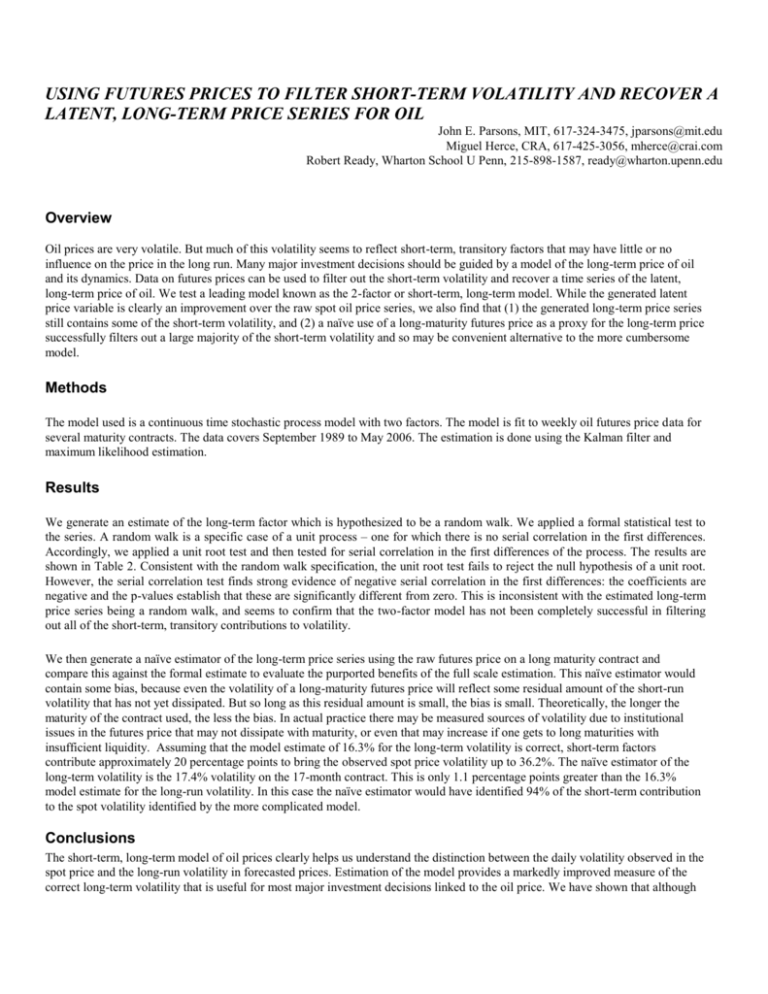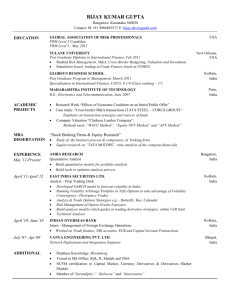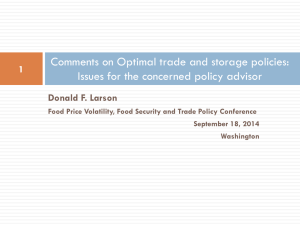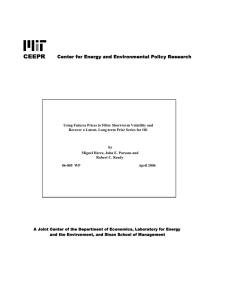Oil prices are very volatile. But much of this volatility seems to reflect
advertisement

USING FUTURES PRICES TO FILTER SHORT-TERM VOLATILITY AND RECOVER A LATENT, LONG-TERM PRICE SERIES FOR OIL John E. Parsons, MIT, 617-324-3475, jparsons@mit.edu Miguel Herce, CRA, 617-425-3056, mherce@crai.com Robert Ready, Wharton School U Penn, 215-898-1587, ready@wharton.upenn.edu Overview Oil prices are very volatile. But much of this volatility seems to reflect short-term, transitory factors that may have little or no influence on the price in the long run. Many major investment decisions should be guided by a model of the long-term price of oil and its dynamics. Data on futures prices can be used to filter out the short-term volatility and recover a time series of the latent, long-term price of oil. We test a leading model known as the 2-factor or short-term, long-term model. While the generated latent price variable is clearly an improvement over the raw spot oil price series, we also find that (1) the generated long-term price series still contains some of the short-term volatility, and (2) a naïve use of a long-maturity futures price as a proxy for the long-term price successfully filters out a large majority of the short-term volatility and so may be convenient alternative to the more cumbersome model. Methods The model used is a continuous time stochastic process model with two factors. The model is fit to weekly oil futures price data for several maturity contracts. The data covers September 1989 to May 2006. The estimation is done using the Kalman filter and maximum likelihood estimation. Results We generate an estimate of the long-term factor which is hypothesized to be a random walk. We applied a formal statistical test to the series. A random walk is a specific case of a unit process – one for which there is no serial correlation in the first differences. Accordingly, we applied a unit root test and then tested for serial correlation in the first differences of the process. The results are shown in Table 2. Consistent with the random walk specification, the unit root test fails to reject the null hypothesis of a unit root. However, the serial correlation test finds strong evidence of negative serial correlation in the first differences: the coefficients are negative and the p-values establish that these are significantly different from zero. This is inconsistent with the estimated long-term price series being a random walk, and seems to confirm that the two-factor model has not been completely successful in filtering out all of the short-term, transitory contributions to volatility. We then generate a naïve estimator of the long-term price series using the raw futures price on a long maturity contract and compare this against the formal estimate to evaluate the purported benefits of the full scale estimation. This naïve estimator would contain some bias, because even the volatility of a long-maturity futures price will reflect some residual amount of the short-run volatility that has not yet dissipated. But so long as this residual amount is small, the bias is small. Theoretically, the longer the maturity of the contract used, the less the bias. In actual practice there may be measured sources of volatility due to institutional issues in the futures price that may not dissipate with maturity, or even that may increase if one gets to long maturities with insufficient liquidity. Assuming that the model estimate of 16.3% for the long-term volatility is correct, short-term factors contribute approximately 20 percentage points to bring the observed spot price volatility up to 36.2%. The naïve estimator of the long-term volatility is the 17.4% volatility on the 17-month contract. This is only 1.1 percentage points greater than the 16.3% model estimate for the long-run volatility. In this case the naïve estimator would have identified 94% of the short-term contribution to the spot volatility identified by the more complicated model. Conclusions The short-term, long-term model of oil prices clearly helps us understand the distinction between the daily volatility observed in the spot price and the long-run volatility in forecasted prices. Estimation of the model provides a markedly improved measure of the correct long-term volatility that is useful for most major investment decisions linked to the oil price. We have shown that although this improvement is significant, there remains some amount of the transient volatility still contained in the model’s estimate of the long-term volatility. We have also shown that a naïve estimator using the raw volatility on the longest maturity futures contract succeeds in filtering out most of the transient volatility caught by the full blown model. This naïve estimator is significantly easier to work with. It requires no complicated statistical knowledge and no implementation of difficult estimation procedures. The formula for estimation can be simply written in a single cell of an Excel spreadsheet. The success of the naïve estimator also provides an opening for the resolution of the conflict over the right price to use in calculating proven reserves for financial reporting purposes. While many of the oil companies have properly complained about the volatility in the spot price and the curious results that follow from that, an alternative that is sometimes proposed is to leave them discretion to utilize whatever price forecast they deem best. Regulators are obviously cautious about granting that kind of discretion. This paper shows, however, that longer maturity futures contracts contain very little of the short-term transitory volatility that is at the heart of the objection to end-of-year spot pricing. They provide a viable alternative that is both simple and effective References Baker, Malcolm P., E. Scott Mayfield and John E. Parsons, 1998, Alternative models of uncertain commodity prices for use with modern asset pricing methods, Energy Journal 19, 115-148. Casassus, J., P. Collin-Dufresne and B. Routledge, 2004, Equilibrium commodity prices with irreversible investment and non-linear technologies, CMU working paper. Dow, J. C. R., 1941, The inaccuracy of expectations: a statistical study of the Liverpool cotton futures market 1921/2-1937/8, Economica 8, 162-75. Gibson, Rajna and Eduardo S. Schwartz, 1990, Stochastic convenience yield and the pricing of oil contingent claims, Journal of Finance 45, 959–976. Gibson, Rajna and Eduardo S. Schwartz, 1991, Valuation of long term oil-linked assets, Stochastic Models and Option Values, D. Lund and B. Øksendal, eds., Elsevier Science (North Holland), 73-101. Hamilton, James D., 1994, Time Series Analysis, Princeton: Princeton University Press. Harvey, Andrew C., 1989, Forecasting, Structural Time Series Models and the Kalman Filter, Cambridge, UK: Cambridge University Press. Kogan, Leonid, Dmitry Livdan, and Amir Yaron, 2005, Futures prices in a production economy with investment constraints, MIT working paper. McDonald, Robert L., 2003, Derivatives Markets, Boston: Addison-Wesley. Routledge, B., D. Seppi and C. Spatt, 2000, Equilibrium forward curves for commodities, Journal of Finance 55, 1297-1338. Schwartz, Eduardo S., 1997, The stochastic behavior of commodity prices: implications for valuation and hedging, Journal of Finance 52, 923-973. Schwartz, Eduardo S., 1998, Valuing long-term commodity assets, Journal of Energy Finance and Development 3(2), 85-99. Schwartz, Eduardo S. and James E. Smith, 2000, Short-term variations and long-term dynamics in commodity prices, Management Science 46, 893-911. Tze, Choong, Dean Foster, Krishna Ramaswamy and Robert Stine, 2005, A dynamic model for the forward curve, Wharton School, Rodney White Center for Financial Research Working Paper 34-05. Williams, Jeffrey C. and Brian D. Wright, 1991, Storage and Commodity Markets, Cambridge UK: Cambridge University Press. Working, Holbrook, 1942, Quotations on commodity futures as price forecasts, Econometrica 10, 39-52.



![[These nine clues] are noteworthy not so much because they foretell](http://s3.studylib.net/store/data/007474937_1-e53aa8c533cc905a5dc2eeb5aef2d7bb-300x300.png)






